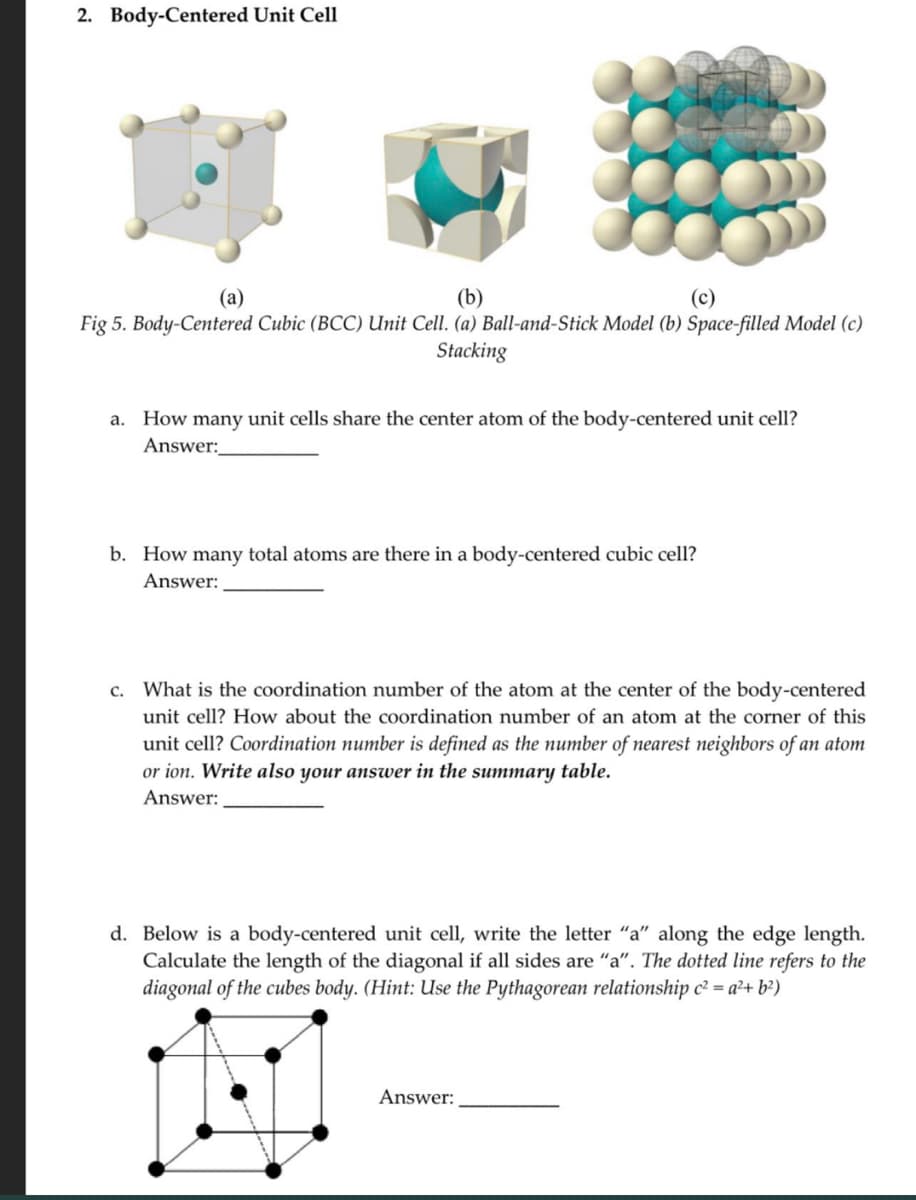2. Body-Centered Unit Cell (a) (b) (c) Fig 5. Body-Centered Cubic (BCC) Unit Cell. (a) Ball-and-Stick Model (b) Space-filled Model (c) Stacking a. How many unit cells share the center atom of the body-centered unit cell? Answer: b. How many total atoms are there in a body-centered cubic cell? Answer: c. What is the coordination number of the atom at the center of the body-centered unit cell? How about the coordination number of an atom at the corner of this unit cell? Coordination number is defined as the number of nearest neighbors of an atom or ion. Write also your answer in the summary table. Answer: d. Below is a body-centered unit cell, write the letter "a" along the edge length. Calculate the length of the diagonal if all sides are "a". The dotted line refers to the diagonal of the cubes body. (Hint: Use the Pythagorean relationship c²=a²+ b²) Answer:
2. Body-Centered Unit Cell (a) (b) (c) Fig 5. Body-Centered Cubic (BCC) Unit Cell. (a) Ball-and-Stick Model (b) Space-filled Model (c) Stacking a. How many unit cells share the center atom of the body-centered unit cell? Answer: b. How many total atoms are there in a body-centered cubic cell? Answer: c. What is the coordination number of the atom at the center of the body-centered unit cell? How about the coordination number of an atom at the corner of this unit cell? Coordination number is defined as the number of nearest neighbors of an atom or ion. Write also your answer in the summary table. Answer: d. Below is a body-centered unit cell, write the letter "a" along the edge length. Calculate the length of the diagonal if all sides are "a". The dotted line refers to the diagonal of the cubes body. (Hint: Use the Pythagorean relationship c²=a²+ b²) Answer:
Chemistry: The Molecular Science
5th Edition
ISBN:9781285199047
Author:John W. Moore, Conrad L. Stanitski
Publisher:John W. Moore, Conrad L. Stanitski
Chapter9: Liquids, Solids, And Materials
Section: Chapter Questions
Problem 115QRT
Related questions
Question
Answer letter d
Handwritten

Transcribed Image Text:2. Body-Centered Unit Cell
(a)
(b)
(c)
Fig 5. Body-Centered Cubic (BCC) Unit Cell. (a) Ball-and-Stick Model (b) Space-filled Model (c)
Stacking
a. How many unit cells share the center atom of the body-centered unit cell?
Answer:
b. How many total atoms are there in a body-centered cubic cell?
Answer:
c. What is the coordination number of the atom at the center of the body-centered
unit cell? How about the coordination number of an atom at the corner of this
unit cell? Coordination number is defined as the number of nearest neighbors of an atom
or ion. Write also your answer in the summary table.
Answer:
d. Below is a body-centered unit cell, write the letter "a" along the edge length.
Calculate the length of the diagonal if all sides are "a". The dotted line refers to the
diagonal of the cubes body. (Hint: Use the Pythagorean relationship c²=a²+ b²)
Answer:
Expert Solution
This question has been solved!
Explore an expertly crafted, step-by-step solution for a thorough understanding of key concepts.
Step by step
Solved in 3 steps with 3 images

Knowledge Booster
Learn more about
Need a deep-dive on the concept behind this application? Look no further. Learn more about this topic, chemistry and related others by exploring similar questions and additional content below.Recommended textbooks for you

Chemistry: The Molecular Science
Chemistry
ISBN:
9781285199047
Author:
John W. Moore, Conrad L. Stanitski
Publisher:
Cengage Learning


Chemistry
Chemistry
ISBN:
9781305957404
Author:
Steven S. Zumdahl, Susan A. Zumdahl, Donald J. DeCoste
Publisher:
Cengage Learning

Chemistry: The Molecular Science
Chemistry
ISBN:
9781285199047
Author:
John W. Moore, Conrad L. Stanitski
Publisher:
Cengage Learning


Chemistry
Chemistry
ISBN:
9781305957404
Author:
Steven S. Zumdahl, Susan A. Zumdahl, Donald J. DeCoste
Publisher:
Cengage Learning

Chemistry: An Atoms First Approach
Chemistry
ISBN:
9781305079243
Author:
Steven S. Zumdahl, Susan A. Zumdahl
Publisher:
Cengage Learning

Chemical Principles in the Laboratory
Chemistry
ISBN:
9781305264434
Author:
Emil Slowinski, Wayne C. Wolsey, Robert Rossi
Publisher:
Brooks Cole

Chemistry: Principles and Reactions
Chemistry
ISBN:
9781305079373
Author:
William L. Masterton, Cecile N. Hurley
Publisher:
Cengage Learning